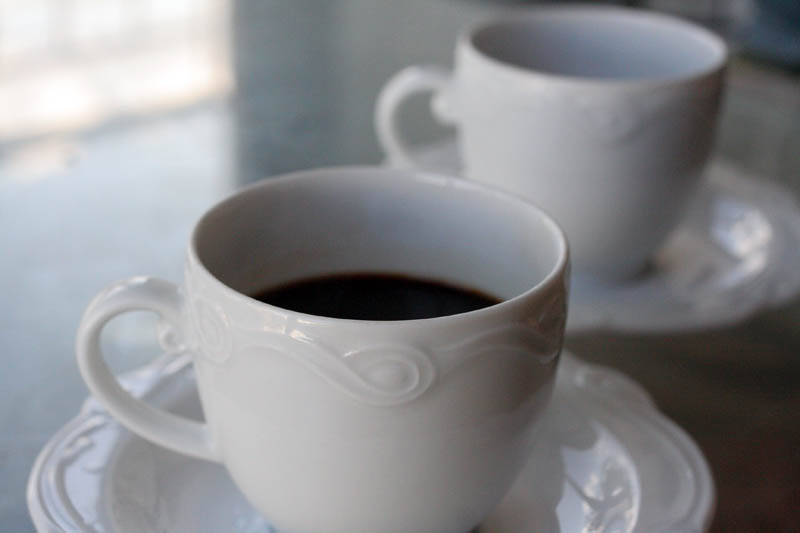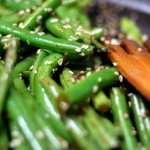Black coffee in Israel gets its distinctive taste from cardamom, that spice you put in pie. It can be either ground with the beans, or added as an afterthought. Coffee with cardamom (cafe im hel) is also known in Hebrew as "mud coffee" (cafe botz). It's the type of thing you drink at Middle-Eastern restaurants, but also in offices, because when faced with a choice of instant coffees, the one made from actual coffee beans inevitably tastes better.
Here are a few anecdotes about the feisty drink, and if you still want to make your own afterward, the instructions are at the end.
This past week, Eitan biked the Israel Trail from Be'er Sheva to Eilat, which is actually more than half the country (yes, I was shocked too, I thought 95% of Israel was Tel Aviv). On his way through the desert he passed by an ashram, which offered its guests refreshments, including coffee. Alongside the coffee was a jar of cardamom, labeled הל (hel) in Hebrew, and translated into English as "hell for coffee."
Now, after living with me for several years, Eitan knew to tell his hosts that "hell" was actually called cardamom, which they scratched under the original English translation with a barely-legible pink pen. I suppose it's fortunate they didn't cross it out, and deny many future visitors a good laugh.
In any case, we woke up today to find we had no power. More accurately, I woke up to the sound of the generator at the falafel place downstairs, right as the power went out. Apparently the other buildings on the block had been informed of the outage. We weren't. And while I very much enjoy my gas stove, which does not need electricity, unfortunately our coffee grinder does. The only ground coffee we had in the house was black coffee with cardamom.
 And now I shall explain why preparing this in a stovetop percolator is not the best idea. Beans prepared for black coffee are ground into a fine powder, which apparently goes straight through the metal strainer of my percolator. The percolator sputtered its way through a few shots of sludge-filled espresso, leaving the upper chamber streaked with coffee grounds.
And now I shall explain why preparing this in a stovetop percolator is not the best idea. Beans prepared for black coffee are ground into a fine powder, which apparently goes straight through the metal strainer of my percolator. The percolator sputtered its way through a few shots of sludge-filled espresso, leaving the upper chamber streaked with coffee grounds.
However, it wasn't a complete disaster. The coffee was less gritty than your usual cup of black coffee, since most of the grounds had stayed put in the central chamber, and the coffee tasted good. And that, I suppose, is the ultimate goal.
In the photo: My Bavarian espresso cups, which I (almost) never have a chance to use. Illustration: My enhanced version of Wikipedia's moka illustration.
How to make cardamom coffee
When prepared properly, the coffee is boiled in a little metal pitcher that sits on the flame, known as a finjan -- Arabic for cup, but taken in Hebrew to mean the device for making coffee.
I use one heaping tablespoon of ground coffee per serving, which comes out to three heaping tablespoons for 2 cups of water or so. Put the coffee grounds into your cooking utensil (you could use a very small saucepan, for lack of a finjan), add water and put it on the flame. You want it to boil actively, but not to boil over.
Once my coffee starts boiling, I usually hold it as high above the flame as necessary so that it doesn't boil over, but close enough to the heat that it keeps boiling. Stir as you go -- you want the foam on top to disappear, and to see only "clean" bubbles that aren't full of coffee grounds.
When this happens, turn off the flame, and add a generous quantity of sugar (to taste). Let the coffee sit for a few minutes before drinking, so that the solid coffee grounds sink to the bottom.
If you're in an office, or somewhere else with a stove, you can just add boiling water, stir, and wait for the particles to settle.
If you're not fortunate enough to live in a country where finely ground coffee is sold premixed with cardamom, you can make your own by grinding coffee to a powder with a few cardamom pods, or by adding ground cardamom to your preground coffee.
Obviously, you can season it to taste, but my coffee place includes about 1 tablespoon of cardamom pods for every cup of coffee beans.




